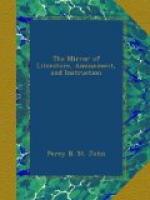From the summit of Arafat, I counted about three thousand tents dispersed over the plain, of which two-thirds belonged to the two Hadj caravans, and to the suite and soldiers of Mohammed Aly; the rest to the Arabs of the Sherif, the Bedouin hadjys, and the people of Mekka and Djidda. These assembled multitudes were for the greater number, like myself, without tents. The two caravans were encamped without much order, each party of pilgrims or soldiers having pitched its tents in large circles or dowars, in the midst of which many of their camels were reposing. The plain contained, dispersed in different parts, from twenty to twenty-five thousand camels, twelve thousand of which belonged to the Syrian Hadj, and from five to six thousand to the Egyptian; besides about three thousand, purchased by Mohammed Aly from the Bedouins in the Syrian Deserts, and brought to Mekka with the Hadj, to convey the pilgrims to this place, previously to being used for the transport of army-provisions to Tayf.
The Syrian Hadj was encamped on the south and south-west side of the mountain; the Egyptian on the south-east. Around the house of the Sherif, Yahya himself was encamped with his Bedouin troops, and in its neighbourhood were all the Hedjaz people. Here it was that the two Yemen caravans used formerly to take their station. Mohammed Aly, and Soleyman Pasha of Damascus, as well as several of their officers, had very handsome tents; but the most magnificent of all was that of the wife of Mohammed Aly, the mother of Tousoun Pasha and Ibrahim Pasha, who had lately arrived from Cairo for the Hadj, with a truly royal equipage, five hundred camels being necessary to transport her baggage from Djidda to Mekka. Her tent was in fact an encampment consisting of a dozen tents of different sizes, inhabited by her women; the whole enclosed by a wall of linen cloth, eight hundred paces in circuit, the single entrance to which was guarded by eunuchs in splendid dresses.




